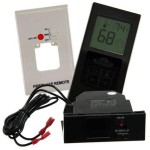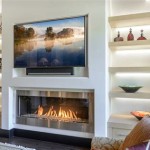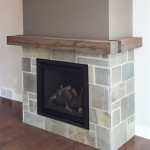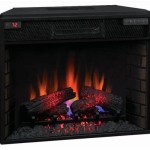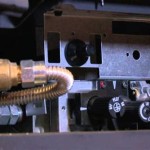Adding a Blower to a Gas Fireplace: Enhancing Heating Efficiency and Comfort
Gas fireplaces offer a convenient and aesthetically pleasing alternative to traditional wood-burning fireplaces. They provide warmth and ambiance with the simple flick of a switch, eliminating the need for wood sourcing, stacking, and ash disposal. However, one common drawback of gas fireplaces is their tendency to radiate heat primarily upward, resulting in uneven heat distribution within a room. The addition of a blower, also known as a fan kit, can significantly improve a gas fireplace's heating efficiency and overall performance.
A gas fireplace blower is a small electric fan installed either beneath or behind the firebox. Its primary function is to circulate the warm air produced by the fireplace into the surrounding room. This forced-air circulation helps to distribute heat more evenly, reducing hot spots near the fireplace and cold spots further away. Consequently, the room heats up faster and maintains a more consistent temperature, enhancing overall comfort, and potentially lowering heating bills. The installation process, while often straightforward, should be approached with caution and diligence, adhering to the manufacturer’s instructions and local building codes.
Key Point 1: Understanding the Benefits of a Gas Fireplace Blower
The advantages of incorporating a blower into a gas fireplace extend beyond mere convenience. The core benefit lies in the improved heating efficiency. Without a blower, much of the heat generated by the fireplace rises directly to the ceiling, creating a temperature gradient within the room. This uneven heating can lead to discomfort, with some areas feeling excessively warm while others remain cool. The blower actively addresses this issue by forcing the warm air to circulate horizontally, ensuring a more uniform temperature distribution throughout the room.
Furthermore, a blower can contribute to energy savings. By efficiently distributing the heat, the fireplace can heat the room more quickly and maintain the desired temperature with less fuel consumption. This translates to lower gas bills and reduced reliance on the central heating system. In effect, the blower allows the fireplace to function as a more effective supplemental heating source, reducing the overall energy demand of the home. The magnitude of these savings will depend on various factors, including the size of the room, the insulation quality of the home, and the frequency of fireplace use.
Another significant benefit is the expedited heating process. Particularly in larger rooms or rooms with poor insulation, a gas fireplace without a blower may take a considerable amount of time to reach a comfortable temperature. The blower accelerates this process by rapidly dispersing the warm air, allowing the room to heat up more quickly. This is especially advantageous during colder months, providing immediate relief from the chill and creating a more inviting atmosphere.
Beyond the practical benefits, the improved heat distribution can also enhance the overall ambiance of the room. By eliminating cold spots, the blower creates a more comfortable and welcoming environment, encouraging relaxation and enjoyment of the fireplace. This contributes to a more pleasant living space, particularly during the winter months.
Key Point 2: Selecting the Right Blower for Your Gas Fireplace
Choosing the appropriate blower for a gas fireplace is crucial for optimal performance and safety. Several factors should be considered during the selection process, including the size and type of the fireplace, the dimensions of the room, and the specific features offered by different blower models. Consulting the fireplace manufacturer's recommendations is paramount, as they often specify compatible blower models and installation guidelines. Using an incompatible blower can lead to overheating, damage to the fireplace, or even safety hazards.
The cubic feet per minute (CFM) rating is a key specification to consider. The CFM rating indicates the volume of air that the blower can move per minute. A higher CFM rating is generally suitable for larger rooms, while a lower CFM rating may suffice for smaller spaces. Determining the appropriate CFM rating involves considering the room's dimensions and insulation quality. A poorly insulated room will require a higher CFM rating to compensate for heat loss.
Noise level is another important factor to evaluate. Some blowers can be quite noisy, which can detract from the ambiance of the fireplace. Opting for a blower with a low decibel (dB) rating can minimize noise disturbance. Many manufacturers provide noise level specifications for their blowers, allowing for informed decisions. Reading customer reviews can also provide insights into the actual noise levels experienced by other users.
Variable speed control is a desirable feature that allows for adjusting the blower’s output to match the desired heating level. This provides greater control over the room's temperature and helps to conserve energy. Some blowers also come with thermostat control, which automatically adjusts the blower's speed based on the room temperature. This feature enhances convenience and further optimizes energy efficiency.
Finally, consider the ease of installation. Some blowers are designed for straightforward DIY installation, while others may require professional installation. Evaluating personal comfort level with electrical work is essential. If unsure, engaging a qualified technician is recommended to ensure proper installation and prevent potential hazards. Safety certifications, such as UL listing, should also be verified to ensure the blower meets established safety standards.
Key Point 3: Installation and Maintenance Considerations
Installing a gas fireplace blower typically involves connecting it to an electrical outlet and securing it within the designated space in the fireplace. Before commencing any installation work, it is imperative to disconnect the gas supply to the fireplace and turn off the electrical power to the unit. This eliminates the risk of gas leaks or electrical shock. Always consult the blower's installation manual for specific instructions and safety precautions. Ignoring these instructions can lead to improper installation, potentially compromising safety and performance.
The installation process often involves removing the fireplace's lower access panel to gain access to the blower compartment. The blower is then typically secured using screws or brackets, ensuring it is properly positioned to direct airflow across the heat exchanger. The electrical wiring must be carefully connected, ensuring the correct polarity and secure connections. If the fireplace does not have a dedicated electrical outlet, a qualified electrician may need to install one.
After installation, testing the blower is crucial to verify proper functionality. Turn on the fireplace and allow it to heat up. Then, activate the blower and observe the airflow. Ensure that the air is being directed effectively into the room and that there are no unusual noises or vibrations. If any issues are detected, immediately turn off the fireplace and blower and troubleshoot the problem or consult with a qualified technician.
Regular maintenance is essential for ensuring the blower operates efficiently and safely. Periodically cleaning the blower blades and surrounding area is crucial to remove dust and debris that can impede airflow and cause overheating. This can be accomplished using a vacuum cleaner with a brush attachment or a can of compressed air. Always disconnect the power before cleaning.
Inspect the electrical wiring regularly for any signs of damage, such as frayed wires or loose connections. If any damage is detected, replace the wiring promptly. It is also advisable to periodically check the blower's motor for signs of wear and tear. If the motor is making excessive noise or is not running smoothly, it may need to be lubricated or replaced. By adhering to these maintenance guidelines, the lifespan of the blower can be extended and its performance optimized.

Fireplace Efficiency Blowers And Why You Should Have One

Why Should I Get A Fireplace Blower For My Masonry

Fireplace Blowers Explained How Fans Work Regency

Adding The Blower To Jotul Gas Fireplace Project Small House

Noisy Gas Fireplace Blower Here S How To Replace It Diy

How To Buy A Gas Fireplace Insert Buyer S Guide From Regency

Fbk 250 Fireplace Blower Kit Installation

Do Gas Fireplaces Need A Blower Fireplace Tips

Blower Vs No Can I Add A To My Gas Fireplace

Blower Vs No Can I Add A To My Gas Fireplace
Related Posts

